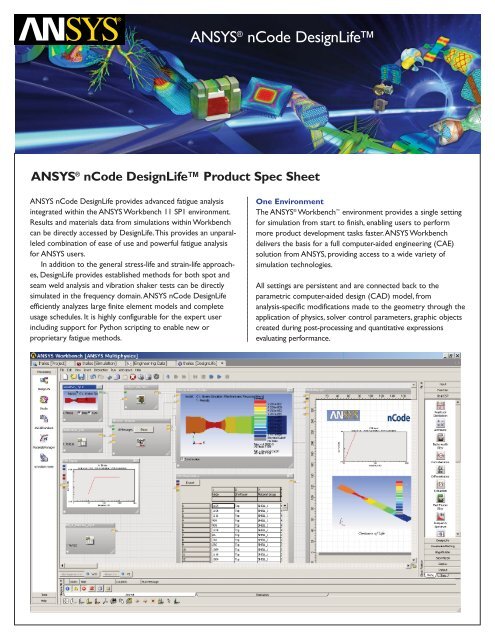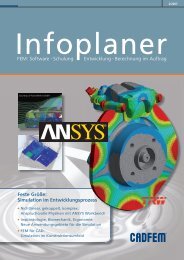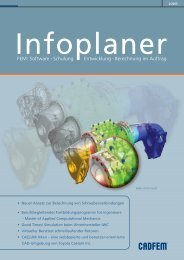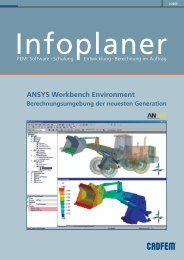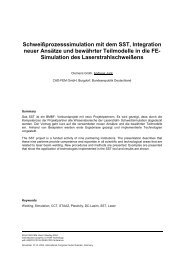ANSYS nCode DesignLife - CADFEM.CH
ANSYS nCode DesignLife - CADFEM.CH
ANSYS nCode DesignLife - CADFEM.CH
Create successful ePaper yourself
Turn your PDF publications into a flip-book with our unique Google optimized e-Paper software.
<strong>ANSYS</strong> <strong>nCode</strong> <strong>DesignLife</strong> provides advanced fatigue analysis<br />
integrated within the <strong>ANSYS</strong> Workbench 11 SP1 environment.<br />
Results and materials data from simulations within Workbench<br />
can be directly accessed by <strong>DesignLife</strong>. This provides an unparalleled<br />
combination of ease of use and powerful fatigue analysis<br />
for <strong>ANSYS</strong> users.<br />
In addition to the general stress-life and strain-life approaches,<br />
<strong>DesignLife</strong> provides established methods for both spot and<br />
seam weld analysis and vibration shaker tests can be directly<br />
simulated in the frequency domain. <strong>ANSYS</strong> <strong>nCode</strong> <strong>DesignLife</strong><br />
efficiently analyzes large finite element models and complete<br />
usage schedules. It is highly configurable for the expert user<br />
including support for Python scripting to enable new or<br />
proprietary fatigue methods.<br />
<strong>ANSYS</strong> ® <strong>nCode</strong> <strong>DesignLife</strong><br />
<strong>ANSYS</strong> ® <strong>nCode</strong> <strong>DesignLife</strong> Product Spec Sheet<br />
One Environment<br />
The <strong>ANSYS</strong> ® Workbench environment provides a single setting<br />
for simulation from start to finish, enabling users to perform<br />
more product development tasks faster. <strong>ANSYS</strong> Workbench<br />
delivers the basis for a full computer-aided engineering (CAE)<br />
solution from <strong>ANSYS</strong>, providing access to a wide variety of<br />
simulation technologies.<br />
All settings are persistent and are connected back to the<br />
parametric computer-aided design (CAD) model, from<br />
analysis-specific modifications made to the geometry through the<br />
application of physics, solver control parameters, graphic objects<br />
created during post-processing and quantitative expressions<br />
evaluating performance.
<strong>ANSYS</strong> <strong>nCode</strong> <strong>DesignLife</strong> is a powerful solution to<br />
predict fatigue life from virtual simulations, making it<br />
possible to:<br />
• Perform virtual durability assessment up front to reduce<br />
reliance on physical test and avoid costly design and tooling<br />
changes.<br />
• Perform smarter and quicker physical tests by simulating first.<br />
• Design durability into your products and reduce warranty<br />
claims.<br />
• Assess more design options, consider more realistic loading<br />
conditions and more confidently reduce cost and weight.<br />
• Standardize analysis processes to improve consistency and<br />
quality.<br />
• Seamless access to results and expanded material library<br />
from simulations within Workbench.<br />
<strong>DesignLife</strong> Standard Package<br />
Stress Life solver<br />
Enables fatigue life calculations to be made using the stress-life<br />
approach. Includes the ability to interpolate between material<br />
curves depending on the temperature. Python scripting can also<br />
be used to add new or proprietary SN methods. Primary application<br />
is high-cycle fatigue (long lives) where nominal stress controls<br />
the fatigue life.<br />
• Material models<br />
- Standard SN<br />
- SN Mean multi-curve<br />
- SN R-ratio multi-curve<br />
- SN Haigh multi-curve<br />
- SN Temperature multi-curve<br />
- Bastenaire SN<br />
- Custom SN using Python<br />
• Mean stress corrections<br />
- FKM Guidelines<br />
- Goodman<br />
- Gerber<br />
• Stress gradient corrections<br />
- FKM Guidelines<br />
- User defined<br />
• Back calculations to target life<br />
Strain Life solver<br />
Enables fatigue life predictions to be made using the local strain<br />
approach. Includes the ability to interpolate between material<br />
curves depending on the temperature at each location. Applicable<br />
to a wide range of problems including low-cycle fatigue with the<br />
local elastic-plastic strain controls the fatigue life.<br />
• FE results input<br />
- Stress<br />
- Linear strain<br />
- Stress & Strain<br />
• Material models<br />
- Standard EN<br />
- EN Mean multi-curve<br />
- EN R-ratio multi-curve<br />
- EN Temperature multi-curve<br />
• Mean stress corrections<br />
- Morrow<br />
- Smith Watson Topper<br />
• Plasticity Corrections<br />
- Neuber<br />
- Hoffman-Seeger<br />
• Multiaxial Assessment<br />
- Biaxial<br />
- 3D Multiaxial<br />
- Auto-correction<br />
• Back calculations to target life<br />
Dang Van solver<br />
Enables Dang Van safety factor calculations. The Dang Van criterion<br />
is a method of predicting the endurance limit under complex<br />
loading situations. The output from the analysis is always<br />
expressed as a safety factor not a fatigue life. Specific material<br />
parameters are calculated from tensile and torsion tests. It has<br />
primary application for engine and powertrain-type applications<br />
where there are very large numbers of loading cycles.<br />
• Multiaxial calculations using the Dang Van approach<br />
• Calculate safety factors, danger factors Tau_zero<br />
<strong>ANSYS</strong> <strong>nCode</strong> <strong>DesignLife</strong> also provides:<br />
• Selection of model subsets for analysis by property id, material<br />
group or user defined set<br />
• Multiple analysis types within the same job<br />
• Multi-stage analyses to focus in quickly on critical areas<br />
• Identification of critical areas and hotspots automatically<br />
• Robust multiaxial assessment methodology<br />
• Looping on input data for multiple calculations<br />
• Support for parallel processing (SMP)<br />
• Interactive or batch mode processing<br />
• Percent certainty of survival using material scatter data.
FE results import<br />
• <strong>ANSYS</strong> ® rst file<br />
• Large file support<br />
• Stresses from 2-D, 3-D solids, shell and membrane elements<br />
• Element centroid, nodal averaged, nodal unaveraged stresses<br />
• Load results from multiple FE results files in the same job<br />
• Linear static, modal or transient/time-step or frequency<br />
response FE results<br />
• Identify surface nodes and resolve stresses to surface plane for<br />
efficient multiaxial processing<br />
• Determine surface normal stress gradients<br />
• Steady state or time varying temperatures<br />
Loading inputs<br />
• Linear superposition, time step, constant amplitude, duty cycle,<br />
aero spectrum input, random (PSD) and swept sine loading<br />
inputs<br />
• Hybrid load provider allows superposition of time series,<br />
transient and constant amplitude loads<br />
• Loading inputs in all <strong>nCode</strong> supported formats<br />
• Read a .laf (load association) file<br />
• Read GlyphWorks schedule files<br />
• Use duty cycles for all analysis types:<br />
- Use different channels in different events<br />
- Mix different types of event within a duty cycle<br />
- Nesting of duty cycles<br />
- Loading sequence<br />
• Duty cycle processing options:<br />
- Calculate event damage independently<br />
- Logically concatenate schedule<br />
- Fast approach including consideration of residuals<br />
• Filter loading inputs for efficient processing<br />
• Functions for import, display and manipulation of loading inputs<br />
• Stress gradient sensitivity taken into account<br />
Results output<br />
• Output results to pipe, FER and CSV<br />
• Output time histories or PSDs from any location (e.g. from<br />
critical areas or gauge locations)<br />
• Multiple sort and filter results for smarter post-processing<br />
(e.g. by part or panel ID)<br />
Post-processing<br />
• Post-process fatigue and stress analysis results in FE-Display<br />
- Make contour and marker plots<br />
- Quickly identify hotspots<br />
- Cursor pick results<br />
• Tabulate, sort and manipulate results<br />
• Produce report pages automatically using the Studio Glyph<br />
Managing Materials<br />
• Import material maps from file (e.g. a bill of materials) or from<br />
pipe - define complete material mapping for each group from<br />
an external .CSV or multi-column input pipe.<br />
• Import part numbers and other information for improved<br />
post-processing<br />
• Database of commonly used material properties with examples<br />
to support all analysis types<br />
• Materials database manager – create, edit or import material<br />
data<br />
• Tabulate and graphically display material curves<br />
• Estimate fatigue properties from monotonic data<br />
• Estimate effects of surface condition on fatigue performance<br />
- FKM guideline method used for roughness and treatment<br />
- Use descriptive or quantitative roughness value<br />
- User input correction factor<br />
- Method applicable to all S-N and E-N calcs
Core components and glyphs<br />
<strong>DesignLife</strong> environment<br />
Studio module for viewing data and creating report templates<br />
Flowproc batch processing of flow processes.<br />
DTProc batch processing of the <strong>nCode</strong>DT fatigue engine.<br />
ASCIITranslate module for converting ASCII data to binary<br />
time series and multi-column formats.<br />
ScheduleCreate module for the creation of schedule files and<br />
CAE duty cycle files<br />
MaterialsManager module for the management of material<br />
databases, including creating, editing and viewing material datasets<br />
FE-Display for graphical display of FE models with stress analysis<br />
results contours within Studio and the FE input and display glyphs.<br />
Add-on <strong>ANSYS</strong> <strong>nCode</strong> <strong>DesignLife</strong> Products<br />
• <strong>ANSYS</strong> <strong>nCode</strong> <strong>DesignLife</strong> Welds<br />
• <strong>ANSYS</strong> <strong>nCode</strong> <strong>DesignLife</strong> Vibration<br />
• <strong>ANSYS</strong> <strong>nCode</strong> <strong>DesignLife</strong> Parallel<br />
• <strong>ANSYS</strong> <strong>nCode</strong> <strong>DesignLife</strong> Accelerated Testing<br />
<strong>ANSYS</strong> <strong>nCode</strong> <strong>DesignLife</strong> Welds<br />
Enables spot-weld and seam weld fatigue life calculations. Several<br />
model methods are supported for each weld type Spot weld<br />
method based on LBF method (SAE 950711). Spot welds are modeled<br />
by stiff beam elements. Cross sectional forces and moments<br />
are used to calculate structural stress around the edge of the weld<br />
spot. Life calculations are made around spot weld using linear damage<br />
summation and reporting worst case. Seam weld method<br />
based on the “Volvo” approach (SAE 982311) and validated<br />
through years of use in industry projects. Support for fillet, overlap<br />
and laser welds with weld toe, root and throat failure analysis.<br />
Spot Weld Analyzer<br />
• Spot weld fatigue analysis using the Rupp/LBF approach<br />
• Beam elements<br />
• Optionally predicts torsional failure mode<br />
www.ansys.com<br />
<strong>ANSYS</strong>, Inc.<br />
Southpointe<br />
275 Technology Drive<br />
Canonsburg, PA 15317<br />
U.S.A.<br />
724.746.3304<br />
ansysinfo@ansys.com<br />
Seam Weld Analyzer<br />
• Seam weld analysis using “Volvo” method<br />
• Applicable to fillet, overlap, and laser welds<br />
• Thickness and mean stress correction<br />
• Bending correction by interpolation<br />
• Weld toe, root, and throat failures may be predicted<br />
• User defined bending ratio threshold<br />
<strong>ANSYS</strong> <strong>nCode</strong> <strong>DesignLife</strong> Vibration<br />
Enables stress-life fatigue calculations based on FE-based<br />
Frequency Response Functions and PSD or swept-sine loading<br />
definitions, including a static offset load case. This provides an<br />
efficient way of analyzing fatigue problems in the frequency domain<br />
with particular application to simulating vibration shaker tests or<br />
loadings well described in the frequency domain such as wind or<br />
wave states.<br />
<strong>ANSYS</strong> <strong>nCode</strong> <strong>DesignLife</strong> Parallel<br />
<strong>DesignLife</strong> can parallel process on machines with multiple<br />
processors (SMP only). Each Parallel License allows another<br />
core to be utilized.<br />
<strong>ANSYS</strong> <strong>nCode</strong> <strong>DesignLife</strong> Accelerated Testing<br />
Accelerated Testing provides the ability to create a representative<br />
PSD or swept sine shaker vibration test based on measured data.<br />
It enables the combination of multiple time or frequency domain<br />
data sets into representative spectra that accelerates the test<br />
without exceeding realistic levels.This option creates the spectra<br />
which are used together with the Vibration Fatigue solver option<br />
to simulate vibration tests.<br />
<strong>ANSYS</strong> <strong>nCode</strong> <strong>DesignLife</strong> Platform Support<br />
• Windows (64-bit): Windows XP 64, Vista 64<br />
• Windows (32-bit): Windows XP, Vista<br />
Toll Free U.S.A./Canada:<br />
1.866.267.9724<br />
Toll Free Mexico:<br />
001.866.267.9724<br />
Europe:<br />
44.870.010.4456<br />
eu.sales@ansys.com<br />
<strong>ANSYS</strong>, <strong>ANSYS</strong> Workbench, HPSS, AUTODYN, CFX, FLUENT and any and all <strong>ANSYS</strong>, Inc. brand,<br />
product, service and feature names, logos and slogans are registered trademarks or trademarks of<br />
<strong>ANSYS</strong>, Inc. or its subsidiaries in the United States or other countries. ICEM CFD is a trademark used<br />
under license. All other brand, product, service and feature names or trademarks are the property of<br />
their respective owners.<br />
Image Credits: Some images courtesy FluidDA nv, Forschungszentrum Joülich GmbH, Heat Transfer<br />
Research, Inc., Riello SPA and iStockphoto.com<br />
© 2009 <strong>ANSYS</strong>, Inc. All Rights Reserved. Printed in U.S.A. MKT0000XXX 9-09


